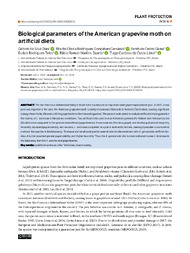Biological parameters of the American grapevine moth on artificial diets.
Biological parameters of the American grapevine moth on artificial diets.
Author(s): DIAS, G. da S.; GERVÁSIO, R. de C. R. G.; GAMA, F. de C.; TELES, E. R.; DUARTE, F. R. M.; COSTA-LIMA, T. C. da
Summary: The São Francisco Submedium Valley in Brazil is the country’s most important table grape exportation region. In 2015, a new pest was reported in the area, the American grapevine moth Lasiothyris luminosa (Razowski & Becker) (Tortricidae), causing significant damage from the bud flowers until the grape berries in the harvesting period. The present work aimed to evaluate artificial diets to guarantee the rearing of L. luminosa in laboratory conditions. Two artificial diets used to rear Anticarsia gemmatalis Hübner and Helicoverpa zea (Boddie) were compared to the species’ natural host (grape berries). It was evaluated the larva, pupal, and larval-pupal period, longevity, fecundity, larval and pupal viability, and sex ratio. L. luminosa completed its cycle in both artificial diets, making it possible to use both to maintain the species in the laboratory. The larval and larval-adult period were shorter for the treatment with A. gemmatalis artificial diet. Also, this diet provided greater pupal viability and higher fecundity. Thus, the A. gemmatalis diet is more indicated to rear L. luminosa in the laboratory than the H. zea diet and grape berries.
Publication year: 2025
Types of publication: Journal article
Unit: Embrapa Semi-arid Region
Observation
Some of Embrapa's publications are published as ePub files. To read them, use or download one of the following free software options to your computer or mobile device. Android: Google Play Books; IOS: iBooks; Windows and Linux: Calibre.
Access other publications
Access the Agricultural Research Database (BDPA) to consult Embrapa's full library collection and records.
Visit Embrapa Bookstore to purchase books and other publications sold by Embrapa.

